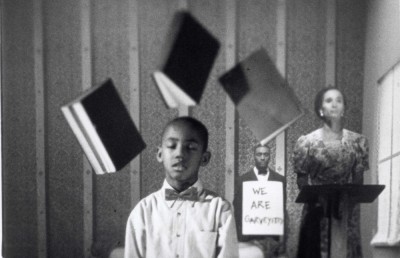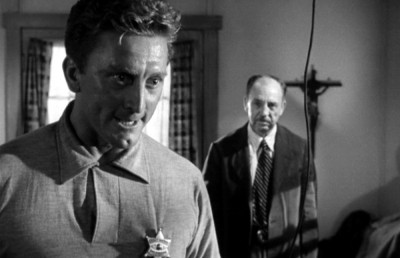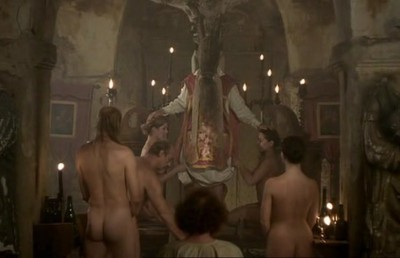Gena Rowlands and John Cassavetes: Equal Stars of A Woman Under the Influence
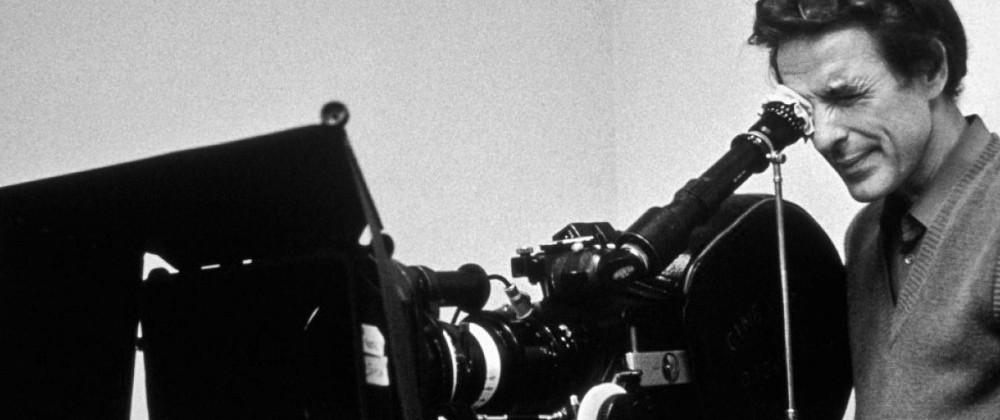
A background in method acting is largely responsible for the fierce independence from the Hollywood system and the consistently stubborn refusal to compromise personal vision that characterises John Cassavetes. Rather than idealising a story by softening the emotional intensity of lovers’ quarrels as so many Hollywood genre films do, A Woman Under the Influence (1974) provides an unabashedly authentic, but fleeting glimpse into how the relationship between one married couple functions under the knowledge that neither they nor their circumstances are likely to change. Moreover, it is due to the great faith that Cassavetes bestows upon his actors that allows for a story of such specificity to work within a cinematic context. Therefore, to read and subsequently extract meaning from the film requires a close examination of the ways in which characterisation and performance create a sense of realism.
Mabel Longhetti, played by Cassavetes’ off-screen wife Gena Rowlands, serves most naturally as the point of reference when discussing characterisation in A Woman Under the Influence. While her story is simple, it suffers each bump in a tumultuous rollercoaster ride of emotional conflicts within the domestic sphere. Initially (or seemingly) a happily married housewife, Mabel becomes institutionalised against her will after reaching her psychological breaking point and, after six months, returns to her idyllic suburban Los Angeles neighbourhood abode, her husband (Peter Falk), and her three children.
Cassavetes establishes the overarching theme of the film – how Mabel is shaped by the influences that constantly surround her – from the very instant we are introduced to her. Rather than presenting Mabel herself on the silver screen and allowing for our first impressions to be formed organically and independently, he filters her through the eyes of two other characters. One of Nick’s construction site colleagues describes her as “delicate,” implying that she is a sensitive and fragile woman, while Nick is quick to refute him, coming to his wife’s defense by explaining that she is not crazy but simply “unusual,” further leading us to believe that Mabel is perhaps emotionally unstable. “Delicate” and “unusual” thus become the frames of reference that we will use to read into her character, and from these conflicting opinions come preconceived notions that will shape that way we feel towards Mabel when she appears later.
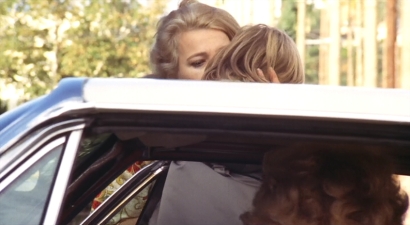
In the following scene, Cassavetes does not formally introduce us to his title character; rather he throws us without any warning into the middle of a situation, interrupting the flow of her day, and the film. Mabel first emerges as an erratic blur darting back and forth from one spot to another as she hurriedly sends her children off with her mother (Lady Rowlands). This is the portrait of any concerned mother, yet we question her sanity due to the rushed pace of the scene and the additional fact that her potentially unhinged nature was suggested in the preceding scene. However, a scene dominated by calm immediately follows this brief storm –alone with a drink in one hand and a cigarette in the other, Mabel wearily waits alone and in silence for her husband to return from work. In this moment, Cassavetes drives home the notion that it is impossible to analyse Mabel on her own because she does not possess an intrinsic set of personality traits and motivations. Instead, her identity is shaped by her interactions with others (in this case, her mother and her children), and throughout the film, the majority of these external influences prove also to be her family members, both atomic and extended.

The idea that an exchange between one person and another serves as the grounds on which internalised emotions are elicited directly stems from Cassavetes’ background in method acting. Not only are his actors required to put their faith in their director, they must also entirely trust their on-screen partners. In portraying Mabel, a woman whose nature and identity is so reliant on those around her, Rowlands puts herself in a psychologically vulnerable position that calls for the elimination of any barriers between her and her co-stars. It can therefore be argued that performance, especially that of Rowlands, is the driving force behind the success of the film as a reflection of Cassavetes’ personal vision.
The lines may be written, but the emotion is improvisation. [1] This sense of improvisation, or rather realism, is a result of both the script itself and the direction that Cassavetes allows his actors to run with it. One of the methods that he used while developing the script involved eavesdropping on outside conversations, writing down word-for-word what he heard, and from these rough but extensive notes, Cassavetes spotted colloquialisms to incorporate into his script. Thus the dialogue often feels improvised because it lacks a sort of carefully strategic cleverness; instead, it is comprised of normal everyday language spoken by those who do not have their lives projected onto the silver screen. As many of us would, Mabel reacts emotionally when she is attacked; she does not respond with witty comebacks, nor does her independence from the apparent normalcy of the outside world take form in the delivery of punchy one-liners.
A complimentary writing method consisted of the use of a tape recorder to capture the tones and rhythms of real speech. Such characteristics include pauses that break the unnatural fluidity of sentences – noticeably inserted when Mabel is defiantly defending herself while Dr Zepp (Eddie Shaw) attempts to convince her to accompany him peacefully to the mental hospital – and overlapping or interrupting dialogue – illustrated clearly in the same scene of Mabel’s breakdown when the characters are screaming their respective opinions over each other. Cassavetes grants Rowlands complete freedom in her interpretation of her character, and appropriately so, for it is she who delivers the lines and ultimately transforms these words into a veritable human being through total embodiment of the role. The justification for Mabel’s motivations cannot be found in Cassavetes’ script; rather it arises from Rowlands’ interpretation and performance.
In conjunction with the delivery of dialogue, physicality, the use of the body as an instrument of communication, is an important component of performance. Since Mabel is neither particularly eloquent, nor able to verbally articulate her emotions, expression of herself is fully embodied, translated through facial cues, gestures, and body language. Following the backyard party fiasco that begins with children faking deaths to the tune of Tchaïkovski’s “Swan Lake” and rather unexpectedly ends in a physical brawl between two angry fathers, Mabel attempts to reassure Nick that she is not in need of professional psychological treatment. Cassavetes’ camera remains stubbornly fixed on her, framing her face in a close-up and not for a moment cutting away to reveal the person to whom she is speaking. By forcing us to process the situation as it unfolds at such a close range, he is not necessarily asking that we sympathise with Mabel. Instead, he is merely giving us the opportunity to observe and analyse her, tracing the minute physical chances on her face as she transitions seamlessly from desperate please, to shocked betrayal, to unbridled fury.
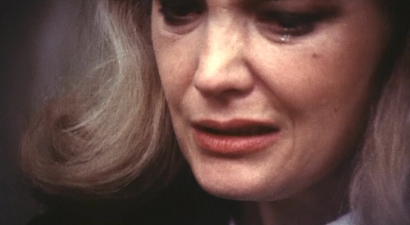
Even the presentation of Mabel reunited with her children after six months is not intended to garner any sympathy for her character. She is once again framed in a close-up, but the visual composition of the shot and the prevailing mood of the scene is much softer, a combination of an out-of-focus image and quiet whispers between mother and children. We are able to see the tears pooling at the corners of her eyes and eventually streaming down her face, but more importantly, this close-up allows us to recognise the difficulty that Mabel is having in her attempt to suppress her emotions and keep her composure under the stressors that lie in wait on the other side of the glass sliding doors.
The employment of close-ups in documenting changes in facial expressions also reinforces the genuine, albeit imperfect, love between Mabel and Nick. Early in the film, Nick finds temporary shelter from the pouring rain in a phone booth and earnestly explains to his wife that he cannot return home in time for their planned date due to an unforeseen incident involving a damaged water main. The camera slowly zooms into and eventually frames his face in a static close-up, revealing an expression of true disappointment over the fact that he must break their plans. Finally, the three words and the simplest of phrases “You’re my girl” convey a sense of genuine love and end the call.
A similar pairing of a zoom-in and a close-up can also be seen in the scene that takes place around the dinner table on the day of Mabel’s return home immediately following her release from the hospital. We are drawn progressively closer to Nick as Mabel begins to tell her joke, the other characters gradually disappearing from the frame, and when the camera settles on his face, it is all too easy to read the overwhelming joy written in his expression. Again, Cassavetes is not reaching out to the audience and asking us to partake in the sentiments of his characters; rather we are only meant to understand that Nick is relieved to see that a semblance of Mabel’s pre-institutionalised self has returned.
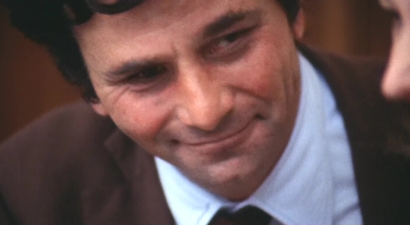
Like these close-ups of facial expressions, physical gestures serve too as distinguishing features of an individual character and as a means of non-verbal communication between Mabel and Nick. The dismissive thumb gesture is closely associated with Mabel, representing the part of her that has not yet been altered by outside influences. When Nick is on the phone with his mother as his construction site co-workers simultaneously proceed to leave his house after the impromptu spaghetti meal, Mabel uses the gesture as a display of utter indifference towards the information that her mother-in-law (Katherine Cassavetes) has fallen ill. She makes use of this gesture a second time when she is helplessly watching Nick playfully pile her mother and their children onto their sofa bed, while impatiently and unsuccessfully attempting to send them on their way.
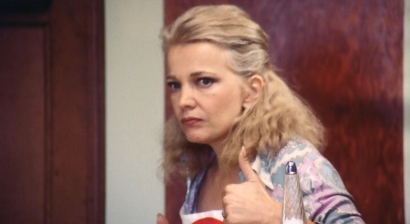
Because this gesture is uniquely tied to Mabel alone, it has an even greater impact on the narrative when it is employed by Nick. When he realises that six months of shock therapy and psychological conditioning has dulled the aspects of his wife that he so adores because he does not possess them himself, he takes her aside and desperately repeats the gesture. This scene is dimly lit, almost to the point of complete darkness, and at one point, Cassavetes cuts away to reveal the other parties present, sitting lost in confusion in the living room. We can only make out shadows and outlines of two figures, yet we can almost feel Nick’s flailing arms, hear the urgency in the associated raspberry sound, and understand that he is using this gesture in a frantic attempt to revert Mabel to what he believes is her former self.
Less specific gestures have a place in the relationship between Mabel and Nick as well, taking the place of words when it comes to their methods of expressing their love for each other. Cassavetes includes these subtle physical cues not as an exclusive secret language shared by his two characters, but as a simple reflection of the reality of human relationships, that exchanged winks, glances, and smiles are often more genuine displays of affection than overused and clichéd phrases. As the construction workers begin to ravenously work into the meal that Mabel has prepared on such short notice, Cassavetes reveals that Nick and Mabel are smiling at each other from across the table, cutting first to Nick’s face, a wide smile in adoration of his wife’s welcoming nature, and then to Mabel’s, a look of flattery and sheepish joy that she did well in pleasing her husband and their guests. During the same scene, but after the eruption that is triggered by Mabel’s unintentionally affectionate behaviour towards Billy Tidrow (Leon Wagner), then furthered by the unexpected call from Nick’s mother, and ultimately raised to its peak in the loud argument between Mabel and Nick, the pair send air kisses to one another in silent reconciliation, seated in the same positions facing each other at opposite ends of the dining table.
In contrast to the subtle changes in facial expressions and communication vis-à-vis little gestures, but still within the category of body language and serving also as an important component of physicality in the performances in the film, are the instances where real violence is not substituted by raising one’s voice or a harsher tone. Cassavetes is certainly not condoning physical brutality as a solution to domestic arguments; instead he is operating on the basis that there is a difference between being violent and having violent emotions, that the act of shooting an individual is neither necessarily nor accurately reflective of anger. The inclusion of this aspect in the film is a direct attack on the tendency of contemporary society to unfairly shun the display of organic emotions in favour of coherent verbal communication. As Cassavetes depicts so clearly in the film, the truth is that the majority of problems and misunderstandings arise due to the sheer impossibility of translating emotion into tangible words.
The film revolves around the premise that because other characters are unable to understand Mabel, she is often left with no choice but to have her physical, exterior actions be a direct reflection of her emotional, interior motivations. Following a frenzied and failed attempt to commit suicide in the bathroom, she tumbles out of the present reality and into a hypnotised state, dreamingly humming the tune of “Swan Lake” while slowly twirling on the living room couch as her husband and children look on. Aware that bloody wrists are not the most appropriate sight for young children and unable to snap Mabel out of her daze, Nick hits her with enough force to knock her off her makeshift pedestal.
In the cases of physicality in place of verbal communication in the film, the explanation is hardly abstract; every emotion can, in fact, be physically expressed. Mabel endures each day in suffering as a result of the inability or unwillingness of others to accept the ways in which she instinctively expresses herself. As she waits for her children at the bus stop, twice in a row she is refused the time because two strangers have impulsively formed the assumption that she is insane based on non-existent evidence. Therefore, it is not so unbelievably farfetched when she brings a razorblade to her wrists out of frustration and when she enters a trance, becoming unresponsive to those around her out of the desire to be alone. Likewise, Nick is not necessarily quick to resort to violence in such situations, he simply understands that verbally pleading for Mabel to immediately stop whatever she is doing is an ineffective means of communication.
Taking Cassavetes’ background in method acting into consideration, meaning in the film is fundamentally anchored in the actors and communicated to the audience through line delivery in nuanced tones and the embodiment of a character through physical cues.2 So too can the importance of the interactions between both the actors and the characters be examined.Recognising the foundation of method acting as line delivery in nuanced tones and the embodiment of a character through physical cues, the importance of the interactions between both the actors and the characters can thus be examined. As mentioned earlier, genuine emotions on the part of the actors require faith in other actors in the scene and are elicited from transactions. Cassavetes incorporates this aspect of method acting into the narrative fabric of the film, portraying Mabel as a woman unable to conventionally vocalise her thoughts and desires, and subsequently indefinable on her own. Therefore, he presents surface situations consisting of raw emotional data from which we must read, analyse, and gather information in order to extract meaning.
Cassavetes depicts life as the process of the autonomous individual navigating external influences, thus the most significant moments of the film take place within a group setting, with multiple characters vying for attention, presenting an opinion, and hoping to steer the direction of the scenario. Worth noting here is that Mabel’s six-month rehabilitation stint is entirely omitted from the film’s plot. Even during her two most volatile moments – her mental breakdown and her equally traumatising homecoming event – Mabel is not allowed to be left alone. The collision of perspectives in these scenes not only drives her to a breaking point, but Cassavetes also manages to overwhelm us to the point of exhaustion by handling these scenes by cluttering the frame with competing points of interest and contrasting emptiness and chaos through editing.
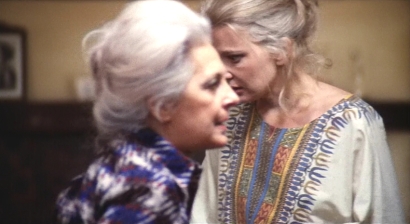
Margaret: “This lady is crazy!”
During Mabel’s breakdown, Nick’s mother serves as an irritatingly superfluous body upholding the opinion that her daughter-in-law should without a doubt be committed as soon as possible. At first, she stands idly by as an outside observer while Mabel attempts to defend herself against Nick and Dr Zepp. Mabel is isolated in the frame, while the other three characters are tightly framed together and occupy three planes of action – Nick in the foreground, Dr Zepp in the mid-ground, and Nick’s mother in the background. Cassavetes cuts between these two images, a visual contrast that illustrates Mabel’s complete solitude in her predicament, trapped and helpless. The physical composition of the frame and the pattern of editing changes, however, when Nick’s mother inserts herself into the conversation after realising that her son appears to have been successfully convinced that his wife does not need psychological rehabilitation. After this point, the four characters are forced to fit uncomfortably within the frame and are screaming over each other, visually and aurally emphasising the tangled mass of influences engulfing Mabel at an incredibly precarious moment in time.
Similarly, Mabel does not return to an empty house after spending six months in a mental institution, but comes home to a slew of half-hearted compliments (“You look well, Mabel, rested!”) from family members, Dr Zepp, and characters that we are never formally introduced to. We only assume that Adolph (Frank Richards), Angela (Elizabeth Deering), and Tina (Jackie Peters) are extensions of the family, since Cassavetes deliberately avoids providing us with any concrete explanation. After Mabel emerges timidly and tiredly from behind the sliding doors after seeing her children, Cassavetes follows up with a static shot that fits within the small space of the frame all the characters that are present for her homecoming, with Tina and the Longhetti children as the only exceptions. The crowded frame in this instance serves not simply to reveal the influences that surround Mabel, but to establish them also as an audience gawking at what is put on display as abnormal.
The scene that takes place around the dinner table is an emotionally stressful situation for both Mabel, who has literally just been released from the hospital and is forced to present herself in a comely manner for a party she did not ask for (an event that even Nick’s seemingly uncaring mother points out the absurdity of), and us, external audience members uncomfortably watching as Mabel is torn apart by the vultures seated around her. Not only does this scene intensify the battle between conflicting opinions, but it also demonstrates the ultimate ineffectiveness of verbal expression as a means of communication for Mabel. She is able, at least initially, to remain calm under immense pressure and to suppress her emotions, as she was instructed to do so during her institutionalisation. Yet when she manages twice to verbally articulate that she would prefer to be left alone, the other characters (in particular, Nick’s overbearing mother) immediately dismiss her request, ignorantly claiming that they know what is better for her under the circumstances. In an even more heart-breaking display of miscommunication, Mabel desperately asks her father (Fred Draper), twice again, to stand up for her. In both instances, he physically stands up, becoming frustrated on the assumption that his daughter’s request is not clear enough and proves ultimately to be unable to understand the simplicity of her plea. In the end, Mabel’s mother chastises her husband, questioning how he cannot possibly see that his daughter merely needs her parents to support her need to be alone at this moment in time.
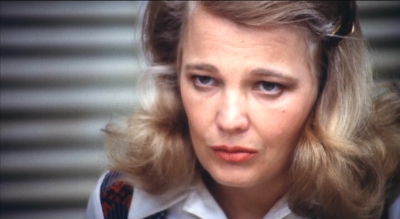
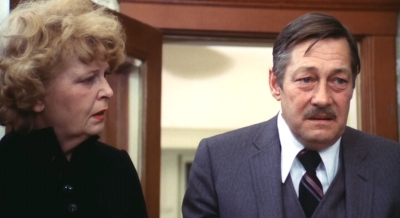
Stand up for me Dad.
The performances of the actors within a group setting in the film sufficiently explains Cassavetes’ disdain for editing, firmly believing that to cut away from one actor to another was to destroy one good moment to focus on someone else. [3] When Mabel reaches her breaking point before and after she is institutionalised, the scenes work not solely because Rowlands pushes her character to the edge and leaves her teetering precariously on the brink, but in conjunction with the reactions that she elicits from her co-stars that she uses as cues and motivations to continue. Within the narrative, these crowded situations depict a perpetual war between Mabel and the influences that she is unable to escape. Yet this world of constant flux is the one in which the film is set and the one in which Mabel must learn and has tried so hard to function.
A Woman Under the Influence arose from a country and era plagued by political conspiracies, national scandals, inexplicable assassinations, and a war-torn home front. But the story that Cassavetes chooses to tell is hardly newsworthy; it is the study of the relationship between one specific married couple and a chronicle of the pain that these two individuals are willing to undergo in simply loving each other. In this way, the film is more so a product of Cassavetes’ own imagination and experiences than it is a result of a chaotic American in the 1970s. Therefore, meaning can be extracted from the realism that arises firstly from the specificity of the characters and their situations, and secondly from the lack of metaphors and abstractions present within the film. As the title states, Mabel is a single, not generalised, woman under the influence. Her predicament is not applicable to all women, nor is her character intended to be representative of the conventional troubled female. It is ironic that Cassavetes’ films are often accused of being inaccessible because in his eyes, and rightfully so, a human relationship, insane as the two parties and unimaginable as their problems may be, is infinitely more fascinating and realistic than any national event dramatised for cinema. Cassavetes is interested in depicting pain through what it is truly caused by, which in the majority of cases is not a bullet or a physical wound, but emotions. We are thus asked to read the surface situations in the film as they are and take the performance of the actors into special consideration as meaning is not presented in confusing, intangible ways.
Not a metaphor for any particular issue faced by the country during this historical period, A Woman Under the Influence is a deliberate and personal work that goes completely against the Hollywood system. By allowing Rowlands to encapsulate the character of Mabel to the extent that she does and presenting raw emotional data with neither a beginning nor an end instead of a story with a concrete resolution, Cassavetes successfully inverts the ways in which classical Hollywood films have conditioned us to read a film. As such, the film belongs deservedly both to its director and its on-screen star.
Endnotes
1 Ray Carney, The Films of John Cassavetes: Pragmatism, Modernism, and the Movies (Cambridge: Cambridge University Press, 1994), 154.
2 Ibid., 165.
3 John Cassavetes and Raymond Carney, Cassavetes on Cassavetes (London: Faber, 2001), 291.
Bibliography
Carney, Raymond. 1985. American Dreaming: The Films of John Cassavetes and the American Experience. Berkeley: University of California Press.
– – –. 1994. The Films of John Cassavetes: Pragmatism, Modernism, and the Movies. Cambridge Film Classics. Cambridge England; New York, NY, USA: Cambridge University Press.
Cassavetes, John and Raymond Carney. 2001. Cassavetes on Cassavetes. London: Faber.


